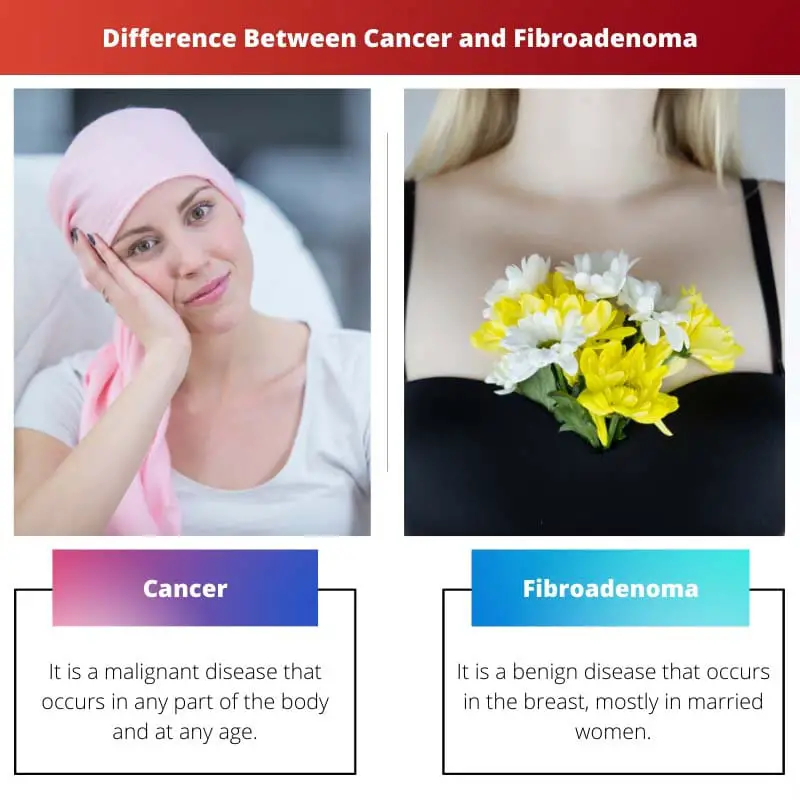A disease is an abnormal condition within a body that affects the normal functionality of organisms. Diseases can be infectious and non-infectious.
Every disease is associated with some symptoms and treatment in the medical field. Cancer and fibroadenoma are different conditions that occur in the body, especially in the breast.
Key Takeaways
- Cancer is a group of diseases involving abnormal cell growth, potentially spreading to other parts of the body.
- Fibroadenoma is a benign breast tumor that doesn’t spread or increase the risk of breast cancer.
- Regular checkups help distinguish between cancerous and non-cancerous growths, enabling appropriate treatment.
Cancer vs Fibroadenoma
The difference between cancer and fibroadenoma is that cancer is an infectious disease that spreads to other parts of the body via blood or lymph. In contrast, fibroadenoma is a non-infectious or benign disease that forms lumps in the breast. Cancer is a painful disease, and fibroadenoma is a painless disease that gets cured by itself.

Cancer is an infectious disease that occurs in anyone. The symptoms are rarely identifiable as every patient experiences different symptoms.
Cancer treatment has side effects that make patients depressed. Breast cancer is most common in women, where lumps form and spread through blood. Most of the time, the treatment may have negative results leading to the patient’s death.
Fibroadenoma is a disease that occurs in the breast, mostly in married women. Lumps are formed in the breast that has a smooth and painless movement.
Fibroadenoma does not spread to other parts. It has no treatment but gets cured by itself after some years. Diagnosis helps to analyze the condition.
Comparison Table
| Parameters of Comparison | Cancer | Fibroadenoma |
|---|---|---|
| Definition | It is a malignant disease that occurs in any part of the body and at any age. | It does not require any treatment as it disappears after some time. |
| Symptoms | In case of breast cancer, Pain, swelling, irritation, swelling, nipple discharge, and others. | There will be no pain, but the lumps move smoothly beneath the skin. |
| Treatment | Chemotherapy, radiation, surgery, and targeted part treatment. | Inheritance, lifestyle, and genetic changes are some of the reasons for the cause. |
| Causes | It does not apply. | It causes during puberty, breastfeeding, and hormonal changes. |
| Spreads | It spreads to other organs via blood | It does not spread. |
What is Cancer?
Cancer is an infectious or malignant tumour that causes the abnormal growth of cells in the body. It spreads to other parts of the body resulting in death.
Various types of cancer occur, such as the lungs, breast, stomach, and others. These cancer cells spread and grow to form tumours in organs. It applies to distant organs via blood or lymph.
Breast cancer is more found in women than men. In breast cancer, lumps form in the breast, spreading to other body tissues. The reasons for causing cancer are lifestyle, quality of food, inheritance from parents, and change in genes.
The breast has three main parts: lobules, ducts, and nipples. Cancer may occur in any of the above parts of the breast.
Lobules cancer, ductal cancer, phyllodes tumour, angiosarcoma, and Paget disease cancer are some cancers. Every case has different symptoms and treatments.
Some cancer tumours proliferate, and some are not identified for years.
Cancer is diagnosed, and treatment is processed depending on the stage. Some treatments include surgery, chemotherapy, radiation, hormone ablation, and targeted therapy.
The patient requires a lot of strength and immunity to handle the pain during and after the treatment.

What is Fibroadenoma?
Fibroadenoma is a breast disease commonly found in married women. It is not cancer and does not spread the infection to other body parts.
Lumps are formed in the breast, but the symptoms are rarely identified as the tumour increases slowly without any pain in the breast. The size of the tumour is from one to fifteen centimetres.
The disease occurs mainly at the time of puberty due to hormonal changes. It happens because of the overgrowth of glandular tissue in the breast. It is diagnosed using ultrasonography to detect lumps.
Some women have either left or right in one breast and some in both. The size of the breast does not change because of this disease.
Usually, the breast contains 15 to 20 lobes which smaller lobes are called lobules. Lobules have somatic cell clusters. Fibroadenoma is a case with an increase in the lobules than average.
Intracanalicular and pericanalicular are two types of fibroadenoma.
In the intracanalicular fibroadenoma, the fibrosis and stroma are lesser than usual in a duct and pericanalicular fibroadenoma, the fibrosis and stroma are more than average in a chimney.
Fibroadenoma is also referred to as breast mouse because there is a free movement of lumps in the breast.
Main Differences Between Cancer and Fibroadenoma
- Cancer is an infectious disease that spreads to other body parts, but fibroadenoma is non-infectious and does not spread.
- Cancer risks the life of the patient, but fibroadenoma does not.
- Cancer is a painful disease, but fibroadenoma is not.
- Cancer occurs to anyone and at any age, but fibroadenoma occurs mostly in married women during pregnancy.
- Cancer has treatments like surgery, chemotherapy, and radiation, but fibroadenoma does not.

- https://www.researchgate.net/publication/331954468_The_Recent_Research_and_Care_of_Benign_Breast_Fibroadenoma_Review_Article
- https://www.google.com/url?sa=t&source=web&rct=j&url=https://www.elsevier.com/%3Fa%3D230374&ved=2ahUKEwiCro-3wIj1AhUGS2wGHRwsCyU4ChAWegQIIRAB&usg=AOvVaw2srxXqbx2GANdXw2prNcEj